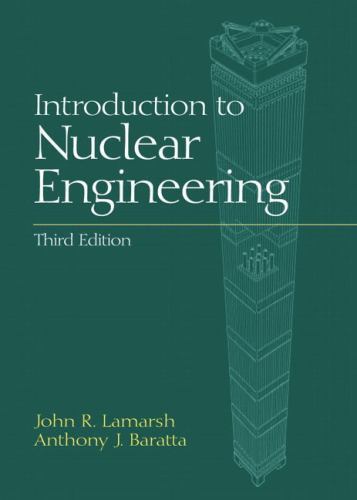Picture 1 of 1

Stock photo

Picture 1 of 1

Stock photo

Introduction to Nuclear Engineering by Anthony J. Baratta and John R. Lamarsh (2001, Hardcover)
B
Brenham Book Company (587)
93.1% positive Feedback
Price:
US $255.79
Approximately£186.49
+ $71.33 postage
Returns:
30 days return. Buyer pays for return postage. If you use an eBay delivery label, it will be deducted from your refund amount. Policy depends on postage service.
Condition:
All units have been revised to reflect current standards. Topics in reactor safety include a complete discussion of the Chernobyl accident and an updated section on TMI and the use of computer codes in safety analysis.
Oops! Looks like we're having trouble connecting to our server.
Refresh your browser window to try again.
About this product
Product Identifiers
PublisherPrentice Hall PTR
ISBN-100201824981
ISBN-139780201824988
eBay Product ID (ePID)95915
Product Key Features
Number of Pages783 Pages
LanguageEnglish
Publication NameIntroduction to Nuclear Engineering
SubjectPower Resources / Nuclear, Chemical & Biochemical
Publication Year2001
FeaturesRevised
TypeTextbook
AuthorAnthony J. Baratta, John R. Lamarsh
Subject AreaTechnology & Engineering
FormatHardcover
Dimensions
Item Height1.3 in
Item Weight43.7 Oz
Item Length9.3 in
Item Width7.2 in
Additional Product Features
Edition Number3
Intended AudienceCollege Audience
LCCN2001-016394
Dewey Edition23
IllustratedYes
Dewey Decimal621.48
Table Of Content(Most chapters end with References and Problems ). 1. Nuclear Engineering. 2. Atomic and Nuclear Physics. Fundamental Particles. Atomic and Nuclear Structure. Atomic and Molecular Weight. Atomic and Nuclear Radii. Mass and Energy. Particle Wavelengths. Excited States and Radiation. Nuclear Stability and Radioactive Decay. Radioactivity Calculations. Nuclear Reactions. Binding Energy. Nuclear Models. Gases, Liquids, and Solids. Atom Density. 3. Interaction of Radiation with Matter. Neutron Interactions. Cross-Sections. Neutron Attenuation. Neutron Flux. Neutron Cross-Section Data. Energy Loss in Scattering Collisions. Fission. y -Ray Interactions with Matter. Charged Particles. 4. Nuclear Reactors and Nuclear Power. The Fission Chain Reaction. Nuclear Reactor Fuels. Non-Nuclear Components of Nuclear Power Plants. Components of Nuclear Reactors. Power Reactors and Nuclear Steam Supply Systems. Nuclear Cycles. Isotope Separation. Fuel Reprocessing. Radioactive Waste Disposal. 5. Neutron Diffusion and Moderation. Neutron Flux. Fick's Law. The Equation of Continuity. The Diffusion Equation. Boundary Conditions. Solutions of the Diffusion Equation. The Diffusion Length. The Group-Diffusion Method. Thermal Neutron Diffusion. Two-Group Calculation of Neutron Moderation. 6. Nuclear Reactor Theory. One-Group Reactor Equation. The Slab Reactor. Other Reactor Shapes. The One-Group Critical Equation. Thermal Reactors. Reflected Reactors. Multigroup Calculations. Heterogeneous Reactors. 7. The Time-Dependent Reactor. Classification of Time Problems. Reactor Kinetics. Control Rods and Chemical Shim. Temperature Effects on Reactivity. Fission Product Poisoning. Core Properties during Lifetime. 8. Heat Removal from Nuclear Reactors. General Thermodynamic Considerations. Heat Generation in Reactors. Heat Flow by Conduction. Heat Transfer to Coolants. Boiling Heat Transfer. Thermal Design of a Reactor. 9. Radiation Protection. History of Radiation Effects. Radiation Units. Some Elementary Biology. The Biological Effects of Radiation. Quantitative Effects of Radiation on the Human Species. Calculations of Radiation Effects. Natural and Man-Made Radiation Sources. Standards of Radiation Protection. Computations of Exposure and Dose. Standards for Intake of Radionuclides. Exposure from y-Ray Sources. Glossary. 10. Radiation Shielding. Gamma-Ray Shielding: Buildup Factors. Infinite Planar and Disc Sources. The Line Source. Internal Sources. Multilayered Shields. Nuclear Reactor Shielding: Principles of Reactor Shielding. Removal Cross-Sections. The Reactor Shield Design: Removal-Attenuation Calculatons. The Removal-Diffusion Method. Exact Methods. Shielding y-Rays. Coolant Activation. Ducts in Shields. 11. Reactor Licensing, Safety, and the Environment. Governmental Authority and Responsibility. Reactor Licensing. Principles of Nuclear Power Plant Safety. Dispersion of Effluents from Nuclear Facilities. Radiation Doses from Nuclear Plants. Reactor Siting. Reactor Accidents. Accident Risk Analysis. Environmental Radiation Doses. Appendixes. I. Units and Conversion Factors. II. Fundamental Constants and Data. III. Vector Operations in Orthogonal Curvilinear Coordinates. IV. Thermodynamic and Physical Properties. V. Bessel Functions. Index.
Edition DescriptionRevised edition
SynopsisShark reaffirms the originality and depth of Terry Jaensche(tm)s poetic vision. Here are poems that explore the territories of childhood, human relationships and the natural world, but never with anything less than an unsettling sense of what it means to be operating from the margins or entering the unspoken core. At once witty and affecting these poems of love and suffering are superbly honed, rigorous and above all emotionally resolute., The text is designed for junior and senior level Nuclear Engineering students. The third edition of this highly respected text offers the most current and complete introduction to nuclear engineering available. Introduction to Nuclear Engineering has been thoroughly updated with new information on French, Russian, and Japanese nuclear reactors. All units have been revised to reflect current standards. In addition to the numerous end-of-chapter problems, computer exercises have been added., Offering the most current and complete introduction to nuclear engineering available, this book contains new information on French, Russian, and Japanese nuclear reactors. All units have been revised to reflect current standards. Includes discussions of new reactor types including the AP600, ABWR, and SBWR as well as an extensive section on non-US design reactors; the nuclear Navy and its impact on the development of nuclear energy; binding energy and such topics as the semi-empirical mass formula and elementary quantum mechanics; and solutions to the diffusion equation and a more general derivation of the point kinetics equation. Topics in reactor safety include a complete discussion of the Chernobyl accident and an updated section on TMI and the use of computer codes in safety analysis. For nuclear engineers.
LC Classification NumberTK9145.L28 2001
All listings for this product
Ratings and reviews
Most relevant reviews
- 03 Jan, 2016
College textbooks
Delivered on time, exactly what was described in the description.Verified purchase: YesCondition: New
- 28 Jan, 2018
Book is required for class
Great price vs the college book store. quick shipping.Verified purchase: YesCondition: New






















